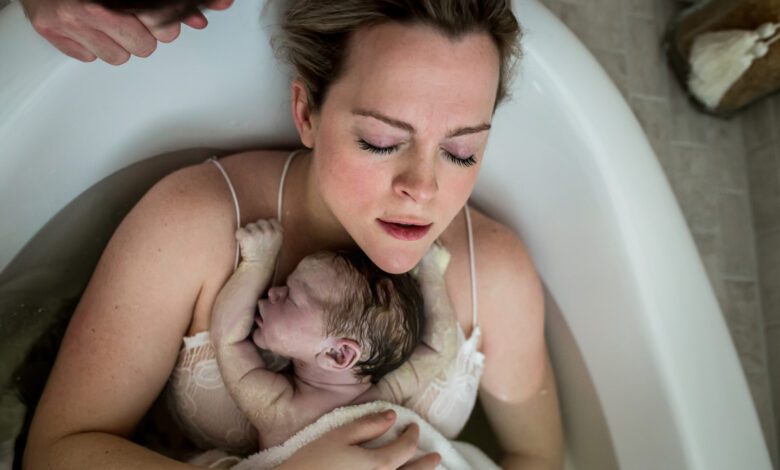Benefits, Risks, and What You Need to Know

Childbirth in America is changing, and expectant mothers are becoming more focused on finding natural options. This has led to an increase in water births – a birth in a tub filled with water instead of a bed – which has been shown to increase a mother’s comfort during labor while reducing their pain.
If you’re nearing your third trimester of pregnancy and looking to see if water birth is right for you and your baby, we’ve listed everything you need to know about this drug-free method and the pros and cons to help you decide .
What is Water Birth?
Water birth is the process of being immersed in a birth pool or tub filled with warm water during labor or when delivering your baby; however, you can do the same in water depending on where you give birth.1
Typically, mommas-to-be stay in the water throughout the first stage of labor when contractions are ongoing, then move to a bed to give birth. If mothers can stay in the water for birth, their baby is born underwater, and they can continue to receive oxygen through the umbilical cord. Within five to 10 seconds, the newborn is gently brought to the surface to breathe.2,3,4
Giving mothers a more natural birthing option, water birth can help ease labor pain without drugs and anesthetics (say goodbye to epidurals!) and keep mothers relaxed and less anxious. Women can also move and shift their bodies in the tub more easily than in a bed, giving them more control during labor.5
For some mommas, a water birth means their little ones can be born in a less stressful environment. They believe that water will be a less disturbing experience, as it may be familiar to their new baby since they spent nine months surrounded by amniotic fluid. Once they arrive, the hope is that their bundle of joy should feel calmer.6
Where Can I Have a Water Child?
Because OB-GYNs do not practice water births widely in the US, they are primarily offered by midwives independent of hospitals. They are usually done during home births or in a birthing center — a free-standing facility that provides a comfortable, home-like environment.7
Although not all birthing centers offer the same amenities, most have private rooms with queen or double beds, rocking chairs or reclining seats, private bathrooms and standing showers, tubs, Bluetooth speakers (to play soothing tired tune, of course) and even some ornaments with motivational messages.
Although limited, some US hospitals have the proper staff and facilities to accommodate water births, but they can be difficult to find. Less than 10% of hospitals offer it as an option for labor and delivery. Many avoid it because of the increased liability associated with water births.5,8
What are the Benefits?
Moms looking for natural pain management, relief from typical labor pains, mobility during labor, and flexibility throughout labor may find their holy grail in water births. Additional benefits of water immersion (also known as hydrotherapy) supported by the American Pregnancy Association include the following:6
- Induces relaxation: Floating in warm water helps moms reduce tension and allows their muscles to relax because they don’t have to fully support their bodies. One study found that working out in water also reduces stress hormones and the fight or flight response, allowing the body to trigger the necessary endorphins that block pain.9
- Reduces the need for medication: When labor pains begin to ease, women can better cope with the pains that come, eliminating the need to rely on medicine and painkillers.10
- May help shorten labor: Yes, that’s right. Water births can help shorten the duration of the first, second, and third stages of labor. This may result from women feeling more relaxed physically and mentally when in the water.11
- Freedom to move as needed: Thanks to the buoyancy of the water, expectant mothers can move freely in a birth pool to find positions that work for them — hello, lower back relief!8
- Lowers your blood pressure: Just as taking a warm shower after a long day helps you forget your worries of the day, hydrotherapy can provide the same feel-good feeling. Hydrotherapy can help lower blood pressure and reduce feelings of anxiety. This allows your mind to be clear and focus more on the birthing process than your worries.12
- Reduces the chance of an episiotomy: Researchers found that the rate of episiotomy was significantly lower in water births than in bed deliveries. At the same time, the number of perineal tears in the study was similar.13
What are the Risks?
Until more data is available, some medical experts advise against water births. Here are some risks that the American College of Obstetricians and Gynecologists (ACOG) and other experts recommend that mothers should be aware of:5,14
- Opportunity for infection: It is common during childbirth that a woman’s bowels move and bodily fluids (such as blood) come out. Women who sit directly in tub water may be more susceptible to infection from bacteria or viruses that come with feces or fluids. Babies can also be at risk if they swallow contaminated water. Although unlikely, this will happen if their oxygen supply from the placenta is compromised. Research is mixed regarding the risk of infection.15,16,17
- Torn at the navel: As with a traditional birth, the umbilical cord can be cut as a newborn is brought to the surface, which can cause the baby to lose blood.6
- Immersion or inhalation of water: If the umbilical cord is wrapped around the baby’s neck or twisted, there is a small chance that they will inhale air and inhale water. However, this is rare, as babies usually breathe only when exposed to air. A 2004 study lists near-drowning and drowning as complications of water birth that parents should be aware of.18
- Fetal distress: It is best to make sure that the water a small child is born in maintains a temperature of about 98 degrees Fahrenheit. If the temperature is too hot, your baby’s heart may beat; if the water is too cold, it can cause anxiety.4
How to Increase Your Chances of a Water Birth
The good news is that water births do not cause increased harm to newborns compared to land births or births that occur out of water and on a bed, according to findings from Oregon State University. Of the 6,500 US-based water births examined, babies were no more likely to be transferred or admitted to a hospital after birth or to be hospitalized within the first six weeks of life after a water birth.19
Although the study shows findings that may help ease a mother’s worries, it’s best to proceed with caution to ensure that water birth is your best and safest option. Here are some factors that may put you at risk:1
- Age: If you are younger than 17 or older than 35
- Health concerns: If your baby is premature or in the breech position, or if you have an infection, are diabetic, or have been diagnosed with preeclampsia, a high blood pressure disorder that occurs in pregnancy.20
- You have more than one loaf in the oven: If you are having twins or multiples.
- You are high risk: If you need to keep track, which cannot be done in a tub.
Ensuring a Safe Water Birth
Even if you don’t check the “at risk” boxes, there are still some things to consider when giving birth in water to keep you and your baby safe:
- Do thorough research on your preferred birthing center to ensure they meet the regulations and standards laid out by the American Association of Birth Centers, such as proper infection control measures.21
- Drink plenty of water to prevent dehydration.
- Ask your midwife to check the temperature of the watermaking sure it stays between 97 and 100 degrees Fahrenheit.
- Make sure you understand the plan if and when you need to transition from the tub. For example, if you decide midway through labor that you’d rather end your labor and birth in bed, ask your midwife what will happen ahead of time so you can feel confident and comfortable if you change your mind.
- Discuss with your midwife and birthing center how emergencies are handled — the more you know, the more relaxed you’ll feel during delivery.
It is important to be careful if you go ahead with a water birth. Talk to your doctor or midwife to see if you’re an ideal candidate for a water birth before moving forward, and base your decision on your comfort levels and your baby’s health.





